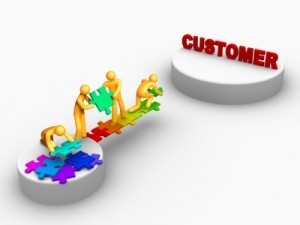Brent Adamson's Blog, page 27
May 16, 2012
Once a Star Coach, Always a Star Coach?

Today’s reps must constantly keep up with an increasingly complex selling environment in which customers only want to talk about price. This has placed added emphasis on sales managers to acquire and fine-tune their coaching skills to make sure they’re adequately coaching reps for this environment. And while we know that coaching has always been a critical component to our sales teams’ success, keeping managers on top of their coaching game is easier said than done.
But why exactly is it so hard?
First, managers have more on their plates than ever. They’re not only trying to make sure their team is highly skilled and motivated, but they’re focusing on driving process adherence, generating forecasts, designing territory plans, managing special projects, and the list goes on. Mangers often feel like they’re working in an environment of reactive “firefighting” and struggle to prioritize responsibilities and determine which activities are the most valuable use of their time.
Secondly, managers are also brushing up on their own skills, as they often need to help ‘unstick’ stalled deals that fall off the tracks in late stages of the purchasing process. Here, our managers are being called on to use a different-in-kind skill set to navigate around deals in creative ways and push them across the final yard to the finish.
Finally, the world of selling is always changing. Both our reps and our customers have greater access to information and technology than they did just two years ago – with new CRM add-ons, tablet technology as selling tools, new social media sites, and the overbearing reliance on the internet, curating through a fire hose of information is undoubtedly an overwhelming part of our daily activities. Nevertheless, data from our 2012 research revealed that star reps are leveraging technology and information-gathering in new ways that even the SEC didn’t expect. Star reps are using social networks to generate their own leads and become a trusted advisor to help them ‘get in’ early.
But if we take a step back and look at these changes, one of the immediate questions they raise is: how does this impact coaching? Any new skill requires experimentation and effective coaching to ensure long-term behavioral sustainment. As we look to our sales managers to double-down on their coaching efforts so that reps are prepared for this new sales environment, many organizations have turned to an interactive coaching boot-camp to ‘reinstall’ star coaching behaviors.
Cisco, for example, built a live workshop training program that both established the company’s standardized coaching approach and tailored training to the needs of their sales managers. To ensure managers retain training on coaching approaches, classroom sessions were followed by in-the-field coaching to assess managers’ progress against their coaching skill gaps identified through direct report reviews.
SEC Members, see how Cisco developed this Closed-Loop Coaching Development Process to train managers at all levels through coaching boot camps tailored to managers’ skill gaps. Also, be sure to check out the key findings on our new research on Shaping Demand Through Pre-Funnel Engagement.
May 15, 2012
Cross-Selling: Mission Impossible?
 The mission seems simple enough: engage customers with additional parts of our business. We know there are additional ways to be partnering with these customers that can benefit both parties. However, it always feels so difficult, often times, nearly impossible. There seems to be these constant barriers to effectively cross-selling to our customers. What gives? If only we had the Impossible Missions Force (IMF) to help us.
The mission seems simple enough: engage customers with additional parts of our business. We know there are additional ways to be partnering with these customers that can benefit both parties. However, it always feels so difficult, often times, nearly impossible. There seems to be these constant barriers to effectively cross-selling to our customers. What gives? If only we had the Impossible Missions Force (IMF) to help us.
Well, we aren’t claiming to be the IMF, but at the SEC we have been able to capture insights from our members about why cross-selling is so hard and what we can do to change that. First, the rep-level impediments to cross-selling:
The short-term focus versus the long-term focus
Lack of knowledge of other products and divisions
The giving up of control
Time and effort spent coordinating with another division
Lack of rewards for cross-selling
It’s certainly not an exhaustive list, and I’m sure you might want to add a few more. But at the end of the day, what it comes down to is that there are some serious rep-level barriers to making cross-selling happen, effectively.
And from an organizational level, the lack of a “referee” across silos really hinders an organization’s ability to execute on cross-selling. There’s no governance, there’s no influence, incentives aren’t aligned and it’s impossible to navigate internal leads and networks.
Our customers out there are also aware of these cross-selling efforts. We asked them “what sales activities undermine the formation of strategic partnerships with suppliers?”…guess what came in at reason #3? Attempt to bundle/unbundle services. Ouch.
So with all of this, what do we do?
Simple: make complexity MANGEABLE, for both the rep and the organization. Here are three ways we’ve seen members successfully do this:
Ingersoll-Rand found a way to focus sales reps on adjacent opportunities with their Segment Opportunity Map. It’s a great visual way to open up reps’ eyes to adjacent opportunities within a customer account. The map becomes a critical roadmap for increasing sales to customers.
Alcatel created a process to support cross-selling. For Alcatel, it wasn’t just about sales reps, it was about the organization enabling cross-selling using a “prescreening tool” to triage opportunities. Functional business units are involved and have a say in the prescreening process to determine the right cross-siloed opportunities to pursue. And it’s not just a process on paper – it includes manager coaching for the rep.
Dimension Data promotes better cross-company collaboration using variable incentives. Their cross-silo deal collaboration incentives reward reps based on lead qualification and the amount of ongoing deal support provided across global opportunities.
So, it turns out we don’t need Ethan Hunt and his team from the IMF to tackle what seems to be a Mission: Impossible. What we do need, however, is a focus on getting sales reps to look for and identify cross-selling opportunities and the organization to enable cross-selling company-wide. It’s a mission we should choose to accept.
May 14, 2012
Ten Phrases Only Bad Managers Say
(This post was originally published by the Market Research Executive Board and the Communications Executive Council but we have updated it from the sales perspective…)
 For many years I looked to Bill Lumbergh from Office Space as my “what not to say” as a manager tutor (“I’m gonna need you to…”).
For many years I looked to Bill Lumbergh from Office Space as my “what not to say” as a manager tutor (“I’m gonna need you to…”).
But we now have an updated list of phrases that should never pass a manger’s lips thanks to workplace expert Liz Ryan. She recently blogged the 10 things only bad managers say. Among the most groan-inducing:
“I don’t pay you to think.”
“Who gave you permission to do that?”
“In these times, you’re lucky to have a job at all.”
What’s the common denominator behind these infuriating catchphrases? Clearly, it’s an overbearing approach to management, which is guaranteed to stifle any agility, innovation or creativity. Years back, this might have been deemed a minor irritant – a trivial complaint that employees’ whimsical ideas weren’t being taken seriously. But as more and more deals today become stuck in ‘no decision’, we’ve got to rely on creativity and innovation in order to get them to close.
So, what do good managers do differently? Our research shows that, in addition to basic management fundamentals, successful managers are great coaches and innovators, and they enable this innovation in their reps.
Top performing sales managers are skillful in each of the three critical components of sales innovation: investigating obstacles, creating solutions, and sharing best practices. Here are some resources to help build your managers skills in these areas:
Help managers and reps understand how to uncover obstacles in the customer’s decision process with our Investigative Questioning Toolkit.
Help managers break their biases and generate new ideas with our Ideation Toolkit.
Reinforce manager innovation skills through peer cohorts – see how Bombardier did this.
Determine how effectively your managers are leading sales innovation efforts with our Manager Innovation Self Assessment.
May 9, 2012
Avoiding the Price-Driven Sale
We’ve all seen this situation play out: one of your average salespeople calls you with great news. “It turns out the Smith account finally called me in! They’re ready to move forward and want us to present next Wednesday!”
We all know what this is. It’s the dreaded bake-off, where three other vendors, including the favorite, will attend, pitch, and essentially help the customer to squeeze more discount from that favorite. (Whether or not the best reps show up is another question I’ll handle in a future blog – turns out they do go, but play by a wildly different set of rules).
But here’s the irony of the situation – while you coach this salesperson to get in earlier while the customer’s needs are being defined and they’re motivated enough to do something, you’re likely setting this rep up for failure. The SEC’s brand new research examines precisely what the best reps are doing to “get in early.”
As it turns out, the idea of “getting in early” has taken a dramatic turn. Today’s customer is so much more informed they’re forcing suppliers to redefine the very meaning of “early.” Not surprisingly, the star reps have evolved most quickly against this informed customer. See the video below to learn what the best reps are doing (make sure you select HD resolution in the viewer if you’re having trouble seeing it).
Teach where customers learn raises a series of implications. Natural questions such as where do customers learn, what do we teach, how do we gain access to customers in those place all come to mind. Over the coming months we look forward to sharing some of the insights from this research.
May 8, 2012
Give Your Reps a LinkedIn Profile ‘Facelift’
(This is the second post in our series on sales organizations’ emerging use of social media as a channel for shaping demand.)
 Social media is a key ingredient for reps to be able to get in earlier and help shape demand. Proactive engagement in digital communities can be effective in sales, but reps will be even more successful with support from their organization. Even without a full social media strategy you can still support individual reps entering the landscape. In the second of our social media blog series we look at some simple things your organization can do to start making your reps’ online presence more professional.
Social media is a key ingredient for reps to be able to get in earlier and help shape demand. Proactive engagement in digital communities can be effective in sales, but reps will be even more successful with support from their organization. Even without a full social media strategy you can still support individual reps entering the landscape. In the second of our social media blog series we look at some simple things your organization can do to start making your reps’ online presence more professional.
LinkedIn is becoming a prerequisite to online professional engagement. Your organization can use a basic checklist to ensure reps all have a minimum online presence in this forum.
There are two reasons why organizational involvement is a good thing: 1) Introducing your reps to the world of social media is a helpful start for those who don’t know how to get into it and 2) a central perspective will allow you some control to align your reps’ personal brand with your company brand.
So what does a good social media profile look like? It must be:
Complete
All basic information categories should be fully filled in with good content. Education, experience, contact details, groups, interests, connections and recommendations are the minimum requirements for a respectable profile. Organizations should also help reps find groups and get recommendations which are often the two most difficult categories to populate.
Personal
Each rep must have a photo. Profiles that include a photo are seven times more likely to be checked than those without a photo. Photos should be professional, clear and a good representation of the person. There should be only one person in the shot, no pets, children or cartoons allowed.
Attention-Getting
A good headline goes beyond a current job description. You can include specialties or successes but make sure it is individual and personal. Bonus points for headlines that imply mentorship, a key ingredient for successful commercial teaching.
Professional
Just like with a resume there is no excuse for any spelling or grammatical errors. If a customer sees that you and your rep are not careful enough to correct than they will not trust you to provide the product or service they need.
And specifically, a good social LinkedIn profile should include:
Helpful Summary
This is the description of your reps’ personal brand but links directly to your organizations overall brand. Have a basic idea of what information you would like the summary to convey. When your reps go into the field what do you hope prospects and customers will think? What do you want your reps to be known for? Make sure each summary has similar language that demonstrates that idea while emphasizing their unique strengths.
Current Job Description
This is the part of the profile your customer will scrutinize so make sure it supports your overall goal. Make sure it fits your company profile and brand. Emphasize specific advantages your rep provided to previous customers and concrete accomplishments that they have achieved. President’s Club means less to clients than saving money, adding value or ROI.
Link to External Pages
Your rep is a reflection of you and viewers should be able to find your company through their profile. Include links to company websites or blogs, Facebook pages or other online spaces.
Using this basic criteria will help ensure that your reps put a professional digital face to your company, something increasingly important for ‘Social Selling’.
SEC Members, use our new LinkedIn Self-Quiz (pg. 3) to rate your (and your team’s) current LinkedIn profile. Also be sure to register for our upcoming webinar on Social Selling: Gaining Credibility and Influence in B2B Social Media Networks.
May 7, 2012
Using CRM to Build Skills, Not Just Track Deals
 While few would disagree that standardization of a process is critical to a company implementing CRM and pipeline management, many still struggle to balance standardization with the need to customize guidance to an individual’s unique needs.
While few would disagree that standardization of a process is critical to a company implementing CRM and pipeline management, many still struggle to balance standardization with the need to customize guidance to an individual’s unique needs.
During pipeline reviews, managers are often left to compare individual pipelines to company averages (e.g. average opportunities per stage, average time per stage, or average close ratio). And that presents a challenge to managers, as the guidance they give to their reps is based on what others do. This means pipeline coaching conversations often sound like this – “well, on average, reps in our segment should have 3X their goal in their pipeline at all times to ensure they’ll hit their goal.”
But when you look at how individual sales reps manage their funnel, every rep is different. They have different average deal size and close ratios, and they spend different amounts of time on deals in different stages. So the number of opportunities they would need to have in each stage to hit goal would vary widely.
Not only does the lack of customization make the data and coaching seem irrelevant from a sales rep perspective, managers are equally limited in their ability to prescribe credible and customized action to reps based on how each of their reps uniquely manage their funnel.
To get over this challenge, we’ve seen companies use software like Crystal Reports to build an interface or tool that pulls historical data on each rep’s pipeline demographics and marries it with real time insight into rep performance at each stage of the funnel—comparing current performance to historical performance for each rep’s book of business.
One company that built this type of tool is SAP/Business Objects, who created the Pipeline Health Calculator. The system accounts for the unique attributes of a sales rep’s funnel, such as sales cycle length, average deal size, conversion rates, time per pipeline stage, and so on.
Managers now have data that is both credible and relevant at the individual rep level, and are now in a position to use the pipeline in a very different way. Managers can look at this information and understand very clearly not only how an individual rep is performing right now, but also what specific behaviors they’d need to change in their reps to improve that performance over time.
The manager is now empowered to say “you have a lot fewer deals at this stage than you normally do – let’s talk about what might be keeping that from happening.”
Companies can also take this a step further, designing the system to prompt managers with potential coaching recommendations so that managers can quickly take action to close any skill gaps. You’ve now got a system to help managers diagnose and prescribe action on a rep’s most pressing long-term development needs.
And to make sure managers stay focused on long-term skill development, design the tool so that it does NOT provide visibility all the way down to the individual deal level. In other words, separate the tool that managers use for deal-level coaching from the one they use for skill-level coaching.
SEC Members, review the full case study from SAP/Business Objects to see how they brought these principles to life (as well as screenshots of the Pipeline Health Calculator tool they built). For more detail, listen to this webinar replay we hosted with Michael Blanchette, Global Sales Enablement Manager for SAP/BusinessObjects, who discussed how they developed their tool.
May 2, 2012
Your Best Source of Untapped Customer Intelligence
 With more access to information than ever before, it’s become clear that customers no longer “need” supplier input to make informed purchase decisions.
With more access to information than ever before, it’s become clear that customers no longer “need” supplier input to make informed purchase decisions.
SEC research shows, on average, customers are 57% of the way through their purchase decision before they make first contact with a supplier—which more often than not means the only thing suppliers are left to compete on is price. With that in mind, the ability for reps to get in early and shape customer demand has become a necessity in today’s world of sales. But how does your organization support reps’ efforts to shape demand?
We know that high performing sales reps have been doing this on their own for quite some time, but it’s been unclear as to how exactly they’ve been going about it—until now.
Our 2012 research shows that high performers’ success at shaping customer demand is attributed to four distinct behaviors, one of which is conducting non-traditional customer due diligence. By surfacing in-depth information about opportunities from outside experts, internal subject matter experts, operations teams, other sales people, partners, customer stakeholders, etc., the best reps cultivate a deep understanding of accounts. High performers then engage customers in the formative stages of their learning process with tailored insight developed from this understanding.
Though non-traditional due diligence is only one of the elements of successful demand shaping, today’s marketplace dictates the need for sales organizations to better support their reps in this activity. Gen-i Corporation, a New Zealand based provider of IT and telecommunications services, is one company doing just this. Gen-i has figured out a clever and scalable way to provide sales reps with valuable due diligence that organizations have traditionally overlooked.
In an effort to better drive account health and profitability, Gen-i shifted from a sales-driven account plan to a business plan that gathers inputs and assesses direction from all stakeholders interacting with the customer. Gen-i trains its customer-facing non-sales staff to use low-risk talking points during their everyday interactions with customer end-users to capture pain points and valuable account intelligence that sales reps are not normally privileged to. Gen-i then brings sales and non-sales staff together to develop a cross-functional business plan informed by this composite account intelligence.
Gen-i’s business plan enables non-sales staff to better serve accounts with business unit-specific goals aimed at bolstering customer loyalty and account profitability. But more importantly, it arms sales reps to shape the nature of demand within accounts by highlighting growth opportunities they would otherwise have been unaware of.
SEC Members, to learn more about the mechanics of Gen-i’s customer intelligence pipeline, the questions they train staff to ask customers, and the cross-functional business plan, make sure to check out the new best practice featured in this year’s study Getting in Early: Shaping Customer Demand Through Pre-Funnel Engagement.
Also make sure to watch out for an upcoming webinar on the subject featuring John Woodyard, Gen-i’s Sales Academy Manager and creator of the best practice, in the coming months.
May 1, 2012
What Should Keep You Up At Night
 How many of us have started off a customer conversation with the following question, “so, Mr. or Mrs. Customer, what’s currently keeping you up at night?”?
How many of us have started off a customer conversation with the following question, “so, Mr. or Mrs. Customer, what’s currently keeping you up at night?”?
Let’s all hold hands and officially mark today’s date as the death of this question. In our survey of thousands of customers that dug into what drives their loyalty, they have explicitly told us they don’t value this approach. What’s more, they’re tired of answering this question for every single supplier that walks through the door.
Customer expectations for the sales experience have shifted in recent years. They expect salespeople to have a perspective on what should be keeping them up at night, not just fire question after question at them.
Now, to provide an experience like this in a manner the customer values, you have to surface opportunities to “reframe” the customer’s views. This is the core commercial teaching moment, where a sales rep introduces the customer to a new way of thinking about his or her business and how to be successful.
To uncover these “reframe” moments, you need to know your unique value proposition – the areas where you (your company, or your solution) outperform the competition. Then work to connect those unique differentiators back to the things the customer is trying to achieve – their outcomes, the metrics they use to determine success or failure.
Here are two questions to consider that will help you work towards a reframe moment for your customers:
1) Who are the most common customer stakeholders (or group of stakeholders) you’re most likely to come up against for a particular solution you are selling (or a segment of customers you are targeting – e.g. CFO’s, Purchasing, Marketing, etc.)?
2) For each stakeholder set identified above, what outcomes* are they trying to achieve as it relates to your solution?
For the most critical outcomes identified for these stakeholders, work to build a reframe story around those that you are uniquely positioned to solve. This is where you must make the connection back to the things that uniquely differentiate you.
*Suggestion: When documenting the customer outcome statements, begin each with either 1) increase or 2) minimize (e.g. “increase the likelihood of X”, “minimize the risk of Y”) – this will help to keep you on track.
SEC Members, for more on reframe moments, visit our Commercial Teaching topic center. Also be sure to register for our upcoming one-day workshop on Challenger Messaging in Chicago on July 17th.
April 30, 2012
iPads® and Tablets as Next-Gen Sales Tools
 Sales organizations are waking up to the numerous benefits of iPads and tablets, and are just realizing how the technology can help reps in their day-to-day activities.
Sales organizations are waking up to the numerous benefits of iPads and tablets, and are just realizing how the technology can help reps in their day-to-day activities.
In a recent member poll, 75% of respondents are already using tablet technology or plan to do so in the next 12 months. While this signals that members see the potential of tablets in Sales, the jury is still out on how effective this technology will be as a sales tool and what risks or drawbacks may be involved.
During our recent webinar on iPads® and Tablets as next-gen sales tools, Ben Calfee, VP of Sales Operations and Enablement at LexisNexis, and Shelley Lawrence, Ph.D, Director of Sales Operations at ENDO Pharmaceuticals, shared their initial experiences with iPads and tablets.
The discussion covered topics including:
Tablet evaluation and pilot programs
Potential uses for the technology
Early results and sales force feedback
Ongoing tablet support and long-term plans
Here are some excerpts from the Q&A:
SEC: What was your reason for launching tablets?
Shelley: It was our Marketing team that expressed a desire to use the technology because it would enable the sales force to use digital versions of promotional materials.
Ben: We were interested in assessing the productivity gains we might be able to achieve from greater mobility and better access to information (email, collateral) online. In addition, a lot of services and products that we sell are online tools and resources, so an iPad helps in actual demonstrations during customer interactions.
SEC: How did your sales force initially begin using tablets in their day-to-day activities?
Shelley: Our first pilot group used the iPad exclusively to access digital resources and email. Several months later, we launched a second pilot in which reps also had access to the CRM system and sample signatures. In addition, we have plans to add some level of sales data and digital resources for more products in the coming months.
Ben: We first launched the iPad out into the field as quarterly incentives for our sales teams, and then we did a more formalized pilot to evaluate its benefits in a more controlled environment.
SEC: Was there any consideration or anticipation of this leading to “canned” presentations by your sales people?
Shelley: Instead of becoming canned, it has led to more customized and tailored discussions. What’s essential here is that reps spend time understanding what’s on their iPad and the best way to use that information. The challenge occurs when reps get confused and don’t know how to find the required information on their iPad while in front of customers.
Ben: Instead of interactions being canned, it has led to us being more nimble. All you need to take care is that you develop collateral in a marginal way so that it’s easier to use.
SEC Members, be sure to check out the full recap of our conversation with Shelley and Ben to learn about customers’ initial feedback to tablet technology as well as the advice they have for other organizations planning to deploy iPads and tablets. You can also access a replay of the webinar, and see the full results from our Tablet Technology survey.
April 25, 2012
The 3 Key Ingredients of Commercial Insight
 You know that your best sellers succeed by teaching customers something new about their business. But what sales messages are your sellers sharing with customers and prospects? And how do you know when you have an insight versus a catchy but fleeting idea?
You know that your best sellers succeed by teaching customers something new about their business. But what sales messages are your sellers sharing with customers and prospects? And how do you know when you have an insight versus a catchy but fleeting idea?
Our most recent findings from this year’s new research study, Getting in Early: Shaping Demand through Pre-Funnel Engagement, reveal that many companies struggle to discern thought leadership from true insight. They often arm their sellers with newsworthy sales messages that grab customer attention but have little lasting impact, and alone are insufficient to create a sense of urgency that translates to customer action.
While we all know and agree that insights are the key to successful selling in a complex environment, companies struggle to generate commercial insights and to know what good insight should look like.
So what exactly is insight anyway?This year’s new SEC research reveals the key ingredients and a basic definition of commercial insight. We think of it as having a few key components. The first component is:
Be credible/relevant – Demonstrate an understanding of the customer’s world, substantiating claims with real-world evidence.
While every insight must have this baseline requirement, it alone is insufficient—you’ll merely have a catchy idea that probably won’t stick. And that is thought leadership in a nutshell – food for thought, but unless it really reframes customers’ current thinking, they will most likely move on to the next new and shiny thing they see. That’s where the next two differentiators come into the picture:
Be frame-breaking – Disrupt the customer’s current logic, revealing an underappreciated aspect of the customer’s environment or a flawed assumption.
Lead back to your unique strengths – Refer customers specifically to areas where you outperform competitors.
This last component, while not important to the customer, is especially important for you as the supplier. If your commercial message meets the first two criteria, but it doesn’t lead back to you, you have just done some free consulting that may benefit your competitors—you have a sharp message, but it’s not commercially viable for you.
SEC Members, learn more about the characteristics of effective commercial insights and see real examples from member companies during our upcoming webinar introducing you to the key findings from this latest research. Also, be sure to register for our upcoming Challenger Messaging workshop where you will take the first steps towards building an organizational capability to generate commercial insights.
Brent Adamson's Blog
- Brent Adamson's profile
- 9 followers



